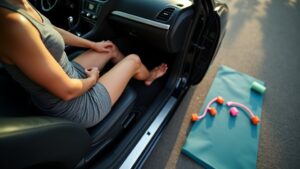Prolonged driving takes a silent toll on hip and leg mobility, locking the body into positions that muscles and joints weren’t designed to maintain. The seated, slightly reclined posture shortens hip flexors, weakens glutes, and stiffens ankles, disrupting natural movement patterns over time. Tight hips, unstable knees, and weakened feet often follow, making everyday activities harder without obvious cause. But small adjustments—like seat positioning and targeted stretches—can undo the damage, restoring fluid movement before chronic issues set in.
The Hidden Impact of Driving on Hip and Leg Mobility
Long hours behind the wheel do more than just get you from place to place—they quietly reshape how your hips and legs move. The seated position shortens and tightens the hip flexor muscles, reducing the hip joint’s natural range of motion. Over time, this can weaken the hip abductor muscles and strain the hip joints, making them more prone to stiffness or injuries.
The feet also suffer, as the constant pressure on the gas pedal flattens the arch and alters leg alignment. Without proper movement, the neuromuscular connection between the hips, knees, and ankles weakens, increasing the risk of injuries during sudden movements. The body adapts to the driving posture, but not without consequences—discomfort and limited mobility often follow.
How Your Driving Posture Affects Muscles and Joints
Ever notice how operating a vehicle leaves your hips feeling stiff or your legs oddly achy? The way you sit behind the wheel can silently strain muscles and joints, leading to long-term issues. A reclined posture with feet on the pedals forces the hips into external rotation, weakening internal rotation over time. The ankles and knees also adapt to this position, disrupting natural movement patterns.
Hip mobility suffers as prolonged sitting tightens the glutes and hamstrings, pulling the pelvis into a posterior tilt. Leg mobility declines whenever the tibia (shinbone) stays externally rotated, flattening the foot’s arch. Back pain often follows, as poor posture strains the spine and surrounding muscles.
Physical therapy can help, but injury prevention starts with mindful seating adjustments. Even minor tweaks reduce strain after a car accident or lengthy commute.
Common Hip and Leg Mobility Issues Caused by Driving
| Issue | Cause | Effect |
|---|---|---|
| Tight hips | Prolonged sitting | Reduced hip mobility exercises effectiveness |
| Foot weakness | Arch muscle underuse | Flattened feet |
| Leg misalignment | Pedal pressure | Duck-footed posture |
Awareness helps prevent these problems before they worsen.
The Science Behind Driving-Related Movement Restrictions
- Hip rotation falters—the pelvis locks in place, limiting internal rotation necessary for walking or squatting.
- Leg mechanics weaken—ankles lose their natural pivot, reducing range and increasing strain.
- Movement patterns degrade—disconnected foot, knee, and hip motion raises injury risks during active tasks.
These changes creep in unnoticed but accumulate over time. Without correction, they disrupt natural movement, making everyday actions harder.
Comprehending the science aids in identifying where to start restoring flexibility and strength. The next step? Reversing the damage with targeted exercises.
Effective Exercises to Restore Hip and Leg Function
Driving-related stiffness doesn’t have to be permanent. Simple exercises can restore hip and leg function, easing pain and improving mobility.
Start with a seated stretch: sit with knees bent and feet flat, then cross the right leg over the left. Lean forward gently until you feel a stretch in the hip. Switch sides to target the left leg.
For tight hamstrings, try a Straight Leg stretch—lie on your back, lift one leg straight, and hold. Strengthening moves like bridges (lying with knees bent, lifting hips) build stability. Side-lying leg raises work the outer hips, counteracting driving’s stiffening effects.
Consistency is key; these exercises, done daily, help undo the damage of long hours behind the wheel.
Practical Adjustments to Protect Mobility While Driving
- Foot flat: Keep the foot flat on the floor to align knees and hips, reducing pressure.
- Floor in front: Place a small cushion under thighs whether feet don’t reach, ensuring hips stay neutral.
- Mobility in the hip: Shift weight slightly every 20 minutes, or circle ankles to boost circulation.
Adjusting seat height and distance helps, too. Knees should align with hips, not dip below. These changes prevent stiffness, making drives less taxing on the body.
Simple habits preserve mobility in the hip over time.
Conclusion
Driving can appear harmless, but over time, it quietly takes away hip and leg mobility. Tight hips, weak ankles, and poor posture creep in, making movement harder. Yet, as the saying goes, “a stitch in time saves nine”—small fixes now prevent bigger problems later. Adjusting seat position, stretching, and strengthening key muscles can undo the damage. With consistency, drivers can reclaim fluid movement and keep their bodies working smoothly for miles ahead.


